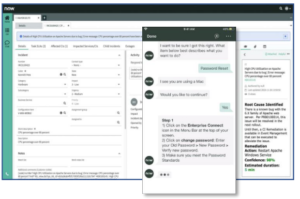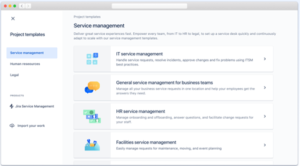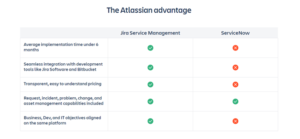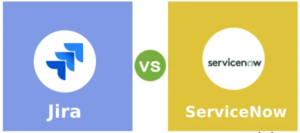
Service Now VS Jira
What is Jira Service Management?
Jira Service Management (JSM) comes under the Jira umbrella of products and is an enterprise-focused tool. It is a combination of the classic Jira features – such as customizable fields and flexible workflows – and agile support methods. This means you get the complete package plus a smooth project experience.
It also boasts customer request tracking and knowledge bases for every stakeholder, to name just a few more of its functions. As it is built on top of Jira it is perfect for any organization already using Atlassian products and it can be easily integrated with third-party applications too such as DevOps workflow.
What is ServiceNow?
ServiceNow is a tool with the purpose of managing an organization’s IT infrastructure and internal/external customer relations. It is extendable through third-party organizations and APIs that your organization may already be using. ServiceNow offers a myriad of applications for ITSM. It boasts a plentiful IT ecosystem, much like JSM, and it offers custom-built integrations from Salesforce.com.
ServiceNow IT Service Management is a modern, cloud-based, silo-busting service management solution. With ITSM, you can consolidate on-premises legacy tools to a single cloud platform and harness shared data and analytics with automated workflows on the Now Platform.


ServiceNow ITSM lets you:
- Empower employees to self-solve issues 24/7, raise questions, and get relevant, accurate, and consistent
information to improve employee satisfaction.
- Make smarter decisions, automate your services, and continually improve your services in role-based
workspaces.
- Triage, collaborate, and enable agents to resolve incidents, find answers, and stay connected from
anywhere to resolve high-impact incidents and improve agent productivity by 30%1
.
Harness shared data and analytics with automated workflows
- Performance Analytics
- Continual Improvement Management
- Service Portfolio Workspace
- Vendor Manager Workspace


Chats, Virtual Agents and Service Operations workspace


Can connect systems and departments on a united platform.


Resource:
Atlassian Advantages
why customers prefer Jira Service Management
- Simple, intuitive implementation
Leverage pre-configured templates to help teams get set up quickly, with out-of-the-box workflows and more.


- Accelerated DevOps
ITSM that’s built on Jira. Break down silos and streamline collaboration between development and IT operations teams.


- Flexible workflows
Get started quickly with a low code editor. Use the drag and drop interface to give teams the flexibility to work how they want.


- Atlassian platform
Give your teams a unified view of their work. Use integrations across the Atlassian portfolio and over 5,000 third party tools to make work flow.




Six reasons teams choose Jira Service Management over ServiceNow


Resources:
Comparisons between Service now and Jira service management


Features:
- ServiceNow is a comprehensive ITSM tool that offers a wide range of features such as incident management, problem management, change management, asset management, and more.
- Jira Service Management, on the other hand, is a more focused tool that primarily focuses on incident and problem management.
Customization:
- ServiceNow is known for its flexibility and ability to be customized to meet the specific needs of an organization.
- Jira Service Management also offers some customization options, but not to the same extent as ServiceNow.
Pricing:
- ServiceNow is generally more expensive than Jira Service Management, especially for smaller organizations.
User interface:
- Jira Service Management has a more user-friendly interface, which makes it easier for non-technical users to navigate and use.
Advantages of ServiceNow:
- Comprehensive ITSM tool with a wide range of features.
- Highly customizable to meet specific organizational needs.
- Strong reporting and analytics capabilities.
- Offers an intuitive user interface.
Disadvantages of ServiceNow:
- Can be expensive, especially for smaller organizations.
- Steep learning curve for administrators and users.
- Requires significant customization to maximize its benefits.
- Can be overwhelming for organizations that do not require all of its features.
Advantages of Jira Service Management:
- User-friendly interface that is easy to navigate and use.
- Affordable pricing, with different pricing tiers to suit different organizational needs.
- Integrates well with other Atlassian tools such as Jira Software and Confluence.
- Offers a range of add-ons and integrations to enhance functionality.
Disadvantages of Jira Service Management:
- Limited feature set compared to ServiceNow.
- Less customizable than ServiceNow.
- Limited reporting and analytics capabilities.
- May not be suitable for larger organizations with complex ITSM needs.
Head to Head Comparison
Jira | ServiceNow |
| The user interface is interactive, and users find it easy to learn and grasp the Jira platform. | Users find it less accessible, and the customer service is not interactive as Jira. |
| Platform updates are done easily without any effort, and practically no money is charged for the same. Hence, users can save their time and enjoy the latest upgrade. The updates are migration free, and users find it easy to understand. | Platform updates are not easy in ServiceNow. If any updates have to be made, the user must do it by himself, and no support will be given from the software end. Also, there can be migration from one platform to other during the update. |
| Visual environments for coding development are not given in the software. Users have to develop the code in their own IDE, and the improvement can be tracked in the software. | Visual environments are provided to the users in low code and coding development. This helps the users to know the output beforehand and to prepare accordingly. |
| Platform service is charged in Jira while doing app development as it is a Jira platform and users find it interactive. | Platform service is not charged, and the platform depends on the user as to how and when to use the services based on the need and usage. There are free and paid add-ons for the users so that they can make proper decisions. |
| Hardware is not shared in Jira as it is not an enterprise related platform. Hence, there are no subscription charges, and services will be provided as usual. | As the hardware is shared in ServiceNow, if the services are used from different systems, the cost will change, and a subscription fee will be added to the additional cost. |
| No extra charges are added to the service if it is based on time-based events, as Jira is basically an issue tracker in the project. Various tasks and issues in the project are checked and notified to the leader. | If the events are correlated and based on time-based events, extra charges are added to ServiceNow’s cost as it is not an issue tracker and is related to the enterprise. |
| Offline capabilities are added in Jira, and changes can be made when the system is not connected to a network as it is based on time-related events. | There is no offline capability in ServiceNow as all the outcomes are stored in the tool with the network’s help, and no changes can be made when the system is offline. |
| Jira platform and Jira software have the same user interface and the same APIs to find it easy with any of the applications inside the Jira software. | The platform and the software are built on various software, and hence the UI and APIs are different. This makes the software more complex, which leads to less productivity. |
Key Difference Between Jira vs ServiceNow
- The price is less for Jira when compared with ServiceNow and is calculated per agent. In Jira, the price is approximately 20 dollars per month per agent, whereas, in ServiceNow, the price is 100 dollars per user per month.
- Jira is always built on the Jira platform and does not use any other platform to work on. ServiceNow is not built on the Jira platform, and this is one of the major differences between the two.
- Jira setup is easy, and installation can be done sooner than expected. ServiceNow installation is not easy, and the setup takes time. Jira takes about 1.2 average months to go live, while ServiceNow takes 4.5 average months to go live.
- ServiceNow’s service depends on the requests raised, and it is not solved by the same group of people who handle other issues. While in Jira, all the requests are handled and solved by a single service desk, making the operations smooth.
- ServiceNow is a cloud-based application and works only on the cloud, and we cannot run the operations on-premises. Jira can be run on on-premise and on cloud platforms.
- ServiceNow is enterprise-oriented and focuses mainly on ITIL. Jira is not an enterprise type, and the look and feel attract more customers than ServiceNow. Any business type can be done in Jira, and the users learn fast to do the process.
- The learning curve is steep in ServiceNow as users find it good to explore different techniques, and the cloud-based platform is used. The learning curve is not steep in Jira, and customers explore Jira for the known use cases and on-premise uses of the project’s software.
- The platform is supported in ServiceNow by providing a community portal and product documentation for the customers. On the other hand, Jira offers a developer portal and a community website so that users can find answers for their queries in the portal itself.
- More integrations and API are provided in ServiceNow, and there is a documented API for building add-ons in the application. In Jira, though documents are provided for building add-ons, custom-built integrations are less, and users must build integrations for their use.
Resources:
https://www.educba.com/jira-vs-servicenow/
Recommendations for selling Jira Service Management against ServiceNow
Assess the customer’s level of ServiceNow Maturity.
Intermediate to advanced maturity ServiceNow customers are less likely to be open to a replace strategy. There’s a high probability that Jira Service Management is being used to help negotiate a reduced rate on their ServiceNow renewal.
We have a stronger replace strategy with low to intermediate maturity ServiceNow customers. These customers often overspend on ServiceNow, using little of the functionality they pay for. Are they getting good value for money? Often the answer is “No.”
If you’re in a deal to replace an existing ServiceNow implementation, it may be better to work on a co-exist strategy in which Jira Service Management works alongside ServiceNow.
Call out the complexity of administering ServiceNow.
Customers are often frustrated by endless upgrade cycles. ServiceNow demands high-touch care and administration.
Jira Service Management is an automatically updated, cloud-native solution. This means Jira Service Management customers can focus on innovation and building new workflows, not upgrading the platform.
Instead of feature-by-feature comparison, focus on Jira Service Management’s business value and modern approach to ITSM. Paint a picture of what’s possible when you improve the workflow between dev and IT teams, especially for customers running on Jira.
If pricing comes up point out that Jira Service Management’s pricing is transparent and publicly available. Custom pricing packages remain complex and confusing even to ServiceNow sales teams.
ServiceNow has been known to discount aggressively for new customers. Jira Service Management pricing is almost certainly going to be lower, even after ServiceNow discounting. Highlight the superior value for money Jira Service Management provides.
Avoid describing Jira Service Management as “simple,” which leads to the perception that the solution is not as robust and cannot scale for enterprise.
ServiceNow has a wide range of products. Understanding which ServiceNow product(s) you’re going against will help you better position Jira Service Management.
Do not recommend too many Marketplace Apps at the start. This may overwhelm the customer. Start with a few critical ones, based on their requirements. Customers can always add additional apps as their usage grows.
Reference:
More Analysis:


Features
Comparing Set-Up and Implementation of Jira Service Management vs ServiceNow
Implementation is a critical stage of your Service Desk journey. Being able to quickly implement your Service Desk software and have it running so that customers and stakeholders are able to take full advantage of the product is important.
JSM wins the race for fast set-up and implementation, taking an average of 1.5 months. According to the G2Crowd IT Service Management (ITSM) Tools Implementation Index, ServiceNow takes almost five times as long.
Time is of the essence in this initial stage of Service Desk set up and JSM delivers. When you think about the customer issue tracking and knowledge building an organization will lose out on when a set-up takes roughly 5 months, you can understand that the consequences are vast. In terms of set-up, JSM is the software to go for.
What About Reporting, Dashboards and Extensions?
ServiceNow offers a plethora of ITIL coverage such as CMBD, service portfolios and requests. However, its reporting and dashboard capacities are basic. Customers that want value-based reports will have to purchase third-party solutions as they are not inbuilt into ServiceNow. There are 200 apps from over 115 partners available to complement the Service Desk. However, researching third-party apps and the download procedure can be tiresome and take up valuable time.
On the other hand, Jira Service Management has an abundance of important features that are inbuilt. You could say that JSM has it all. Its report and workflow features and a great service level agreement are just a few of the reasons the program stands out. Not to mention the all-in-one ticketing, filtering and reporting which are indispensable when your company wants to perform at its highest level, providing valuable help and knowledge to those that request it.
Similarly to ServiceNow but on a larger scale, there are over 600 extensions available to Jira Service Management. These are all accessible through the Atlassian Marketplace, meaning you can enhance the app’s basic functions to suit your needs. You can even use the filters button to select the ‘highest rated’, which will reduce the research and time needed to select extensions.
Agility:
Jira Service Management operates under Agile, “an iterative approach to project management and software development that helps teams deliver value to their customers faster and with fewer headaches.” Agile helps teams complete their projects more efficiently by delivering work in small increments. This means requirements, plans and results are continually being updated and evaluated creating a smooth running machine that responds to change.
Agile is something which, once you’ve tried it, is invaluable. In fact, a report by Harvard Business Review Analytic Services stated that Agile gave organizations “the competitive advantage for a digital age”. In the report, it was found that being Agile improved employee satisfaction by 20%-40%. This is a huge breakthrough in terms of Service Desk operations as it shows that employees, the main stakeholder in any business, were satisfied with the product and their ability to work with it.
The Agile approach is something ServiceNow does not offer, and neither does it have a close equivalent. When comparing JSM vs ServiceNow this is something to be considered, especially when accounting for the numerous amounts of praise Agile receives across the board.
Do They Offer Regular Updates?
Regular updates show that the software is staying up-to-date and the provider cares about making improvements. Updates are a green flag when it comes to a company listening to and implementing feedback and are usually a steadfast sign of a good product.
JSM provides between three and four major update releases per year, on top of regular bug-fixing releases. This is twice as much as ServiceNow which releases roughly two new versions a year.
You may not think this difference is a deal breaker but when you start to look at the bigger picture it can be. Updates can be the make or break between getting work and issues sorted on time and efficiently, so it is definitely something to consider when picking a Service Desk software.
Cloud vs On-Premise
ServiceNow is available only on cloud. In many respects this is great, cloud is the future and more and more companies are switching from server to cloud software. It has several advantages such as scalability and less time spent on installing servers into office space.
However, you can access JSM on cloud and on-premise. Simply having the option is an advantage in itself as it gives you a choice for what is the best for your company. It truly is the best of both worlds where you receive the benefits of the cloud but also have the functions that come with on-premise.
User Friendliness
If one thing is certain, it’s that a Service Desk has to be user-friendly. There is no point in stakeholders raising queries and the company creating knowledge bases if no one can use these functions efficiently.
JSM boasts the title of Customers Choice 2022 in the Gartner Peer Insights list and is trusted by over 35,000 customers globally. Its UI, as noted above, is modern and sleek, creating an intuitive experience.
ServiceNow has a user-friendly front-end experience, however, it is more ITIL-focused making accessibility for smaller organizations less desirable. This is not the case with Jira Service Management which is easily accessible to all sizes of organizations.
On Support
As far as support goes, JSM goes above and beyond. Atlassian has a range of standard and premium options such as weekend coverage and shortened response windows. If you are willing to pay for the enterprise option you can expect a response in under 30 minutes and a dedicated response team to help you with any issues you face.
ServiceNow offers 24/7 support 356 days a year. However, this is only available to US-based customers and instead, it only offers its global customers web and email support. This can be useful for quick queries and FAQs but lacks a dynamic and personal approach.
Cost
ServiceNow starts its yearly pricing options at just over $10,000 for the Express version. However, their pricing options and variability are rather vague and a consultation is required before proceeding. This involves a business value assessment and ‘pricing tailored to your requirements’. Although this custom price range is marketed as a benefit to the customer it can be unhelpful in terms of transparency. Moreover, It requires time and focus to communicate with ServiceNow and agree on a deal.
On the other hand, JSM has a transparent pricing structure which avoids awkward and time-consuming negotiations. The pricing structure is straightforward and manageable for all sizes of businesses and budget-consciousness. In fact for agents of three or fewer Jira Service Management is free, after this, there is the standard option at $600 a year and then the next level is the premium at $1,350 pa. Each level comes with an increase in benefits however, all the levels have the basic Service Desk package.
Summary and how to win the comparison.
While both ServiceNow and Jira Service Management are great ITSM tools, Jira Service Management has some distinct advantages that make it a popular choice for many organizations:
User-friendly interface: Jira Service Management has a simple and intuitive interface that makes it easy for non-technical users to navigate and use. This means that it can be quickly adopted by teams and users without much training.
Another description: Jira Service Management is known for its ease of use, which leads to higher user adoption rates. This means that more team members are likely to use the tool, which can lead to increased collaboration and better outcomes.
Affordable pricing: Jira Service Management offers a range of pricing options to suit different organizational needs, making it an affordable option for smaller organizations or teams with limited budgets.
Another description: Jira Service Management is a more cost-effective option than ServiceNow, particularly for smaller organizations or teams. This cost-effectiveness extends beyond the initial licensing fees, as Jira Service Management also requires less effort and resources to implement and maintain.
Integrations: Jira Service Management integrates well with other Atlassian tools such as Jira Software and Confluence, allowing for streamlined workflows and increased collaboration.
Another description: Jira Service Management is part of the Atlassian suite of tools, which means that it integrates seamlessly with Jira Software. This integration can be beneficial for teams that use Jira Software for project management or issue tracking, as it allows for a more unified workflow.
Add-ons and integrations: Jira Service Management offers a range of add-ons and integrations to enhance functionality beyond its core feature set.
Customization: While Jira Service Management is not as customizable as ServiceNow, it still offers some level of customization to meet specific organizational needs.
Another description: While ServiceNow is highly customizable, it requires significant effort and resources to tailor it to an organization’s specific needs. Jira Service Management, on the other hand, offers a more streamlined customization process that allows teams to adapt the tool to their workflows and processes quickly.
Agile capabilities: Jira Service Management is built on agile principles, which means that it is highly adaptable and can easily accommodate changes in workflows or processes. This can be particularly useful for teams that operate in fast-paced environments where requirements can change quickly.
In summary
Jira Service Management is a user-friendly, affordable, and flexible ITSM tool that integrates well with other Atlassian tools and offers a range of add-ons and integrations to enhance its functionality. While it may not be as comprehensive as ServiceNow, it is a great option for smaller organizations or teams with simpler ITSM needs and want to optimize for ease of use and cost-effectiveness.